Dennis Bryant
-
- Maritime Quarantine & Isolation Maritime Reporter, Dec 2014 #16
Seven years ago, I authored an article on quarantine and isolation. With the outbreak of Ebola virus disease (EVD) in West Africa, it is time to dust off and update that article.
The concepts of quarantine and isolation lie at the juncture of medicine, law and public safety. When these concepts intersect with the maritime community, things quickly get both interesting and complicated.
Quarantine and isolation have been invoked in cases of communicable diseases throughout human history. Special treatment of lepers is mentioned in the Bible. During the Middle Ages, the Venetians required ships arriving from suspect areas to anchor out of port for 40 days, based on the assumption that any disease on board would run its course during that time. Modern quarantine and isolation are more sophisticated, but only slightly. The outbreak of severe acute respiratory syndrome (SARS) in 2002 revealed the difficulty of instituting efficient and effective quarantine and isolation protocols in an interconnected world village. EVD, and its isolated occurrence in the United States and Western Europe, have provoked fresh reactions. Other illnesses, such as avian flu and Middle East respiratory syndrome (MERS), present their own challenges.
Congressional hearings have been held. Some members of Congress have called for travel bans. Health agencies and law enforcement agencies are re-examining their procedures and their authorities and have commenced enhanced monitoring of arrivals. The U.S. Coast Guard and sister agencies in other port states have issued requirements for and reminders relating to disease reporting. New regulations and enhanced utilization of existing protocols should be expected. Concern about a possible pandemic caused by an emerging disease is growing.
Definitions
Now is a good time to define some terms. “Epidemic” is the widespread occurrence of a disease. A “pandemic” occurs with the outbreak of a new contagious disease that causes death or serious illness in large numbers of persons. EVD is not considered to be likely to develop into a pandemic. While highly virulent with a death rate of about 50% among those infected, it has a low capacity for contagion. SARS is a recent example (but fortunately was stopped before becoming widespread, making it an epidemic rather than a true pandemic), but the Black Death in the Middle Ages, the so-called Spanish flu in 1918-1919 and flu outbreaks in 1957 and 1968 are other examples. “Isolation” involves the separation of a person who has been diagnosed with a specific infectious disease from those who are healthy and a restriction of the movement of that individual to stop or deter the spread of the illness. In most cases, isolation is voluntary, but authority exists for compulsory isolation if proven necessary. Persons in the United States diagnosed with EVD have been placed in isolation. “Quarantine” is the separation and restriction of movement of persons who, while not yet ill, may have been exposed to an infectious agent. As with isolation, quarantine is generally voluntary, but may be enforced when and if necessary.
International Impact
SARS, which was first identified in southeast China and Hong Kong in late 2002, provides a good example of a potential pandemic and the impacts that flow therefrom. While governments did not impose mass quarantines and isolations, travel was effectively restricted and commerce was impaired. The SARS epidemic caused over 8,000 reported cases of the condition, including almost 800 fatalities. In China, Hong Kong, and Southeast Asia during the height of the epidemic (second quarter of 2003), the gross domestic product of the affected nations is estimated to have dropped 2% on average. If a pandemic were to occur in the near future with the same severity as SARS, but not so limited in geographic impact, the World Bank estimates an economic impact of approximately $800 billion.
EVD has had less, but noticeable, impact on travel and trade. Various airlines have ceased regular flights to the affected West African countries. Maritime trade has been restrained for ports in the region. Owners, operators and traders have started inserting into charters and other contracts clauses to address the threat of EVD, seeking to minimize the risk of delay if a vessel after calling at a port in West Africa transits to other ports. If delay occurs, some clauses allocate in advance the financial liability that ensues.
Justifiably, concern about a potential pandemic is widespread. The World Health Organization (WHO), a sister agency to the IMO within the United Nations, implemented new and enhanced International Health Regulations on June 15, 2007. The regulations are intended to provide for improved procedures for addressing significant health emergencies and address a wider range of medical conditions than previously. Among other things, the revised IHR provide for a declaration of health by ships and for minimum sanitary conditions for cargo loading areas, including areas where shipping containers are packed. Following the EVD outbreak, the WHO issued biorisk reduction guidance, but has specifically stated that bans on travel and trade are inappropriate. The IMO has endorsed the WHO position.
United States Approach
In the United States, isolation and quarantine are generally matters for state and local health authorities and law enforcement agencies. Only when the problems involve interstate and international movement and exceed the ability of local control do the federal authorities normally step in.
At the federal level, quarantine and isolation are primarily the responsibility of the Centers for Disease Control and Prevention (CDC). The CDC is empowered to detain, medically examine or conditionally release individuals reasonably believed to be carrying a communicable disease. The list of quarantinable diseases is established by a 2003 Executive Order, which was amended in 2005 to include “influenza caused by novel or reemergent influenza viruses that are causing, or have the potential to cause, a pandemic” and in 2014 to redefine severe acute respiratory syndromes. As of the date of writing this article, EVD has not been added to the specific list. Isolation or quarantine, though, may be ordered by state or local authorities if appropriate.
Changes in Regulations
In recent years, the quarantine and isolation regulations have been amended several times. The changes, among other things, make it easier for the CDC to require a ship clearing or departing a foreign port bound for the United States to obtain a bill of health from the US consular officer for that port setting forth the sanitary history of the vessel. The CDC can also suspend, in whole or in part, entries and imports from designated foreign countries or places. This would be done when the CDC Director determines that the risk of introduction of a disease into the United States is increased by the introduction of persons or property from such foreign countries or places.
Operators of ships on international voyages are required to report deaths or illnesses prior to arrival. Operators are required to report not just persons on board with a designated communicable disease, but persons defined as ill, meaning a person who: (1) has a temperature of 100.4°F (38°C) or greater accompanied by one or more of the following: rash, swelling of lymph nodes or glands, headache with neck stiffness or changes in level of consciousness or cognitive function; (2) has a temperature of 100.4°F (38°C) or greater that has persisted for at least 48 hours; (3) has more than common diarrhea; (4) has severe bleeding, jaundice or severe persistent cough accompanied by bloody sputum, respiratory distress or a temperature of 100.4°F (38°C) or greater; or (5) displays other symptoms or factors that are suggestive of communicable disease.
Arriving vessels are subject to inspections and sanitary measures may be directed if there is evidence that the ship or something on board is or may be contaminated with a communicable disease. The ship may be detained until satisfactory sanitary measures have been completed. The owner of the ship would bear any expenses relating to sanitary measures and detention. In the case of animals, articles or things on board the ship, any expenses relating to detention would be borne by the owner thereof.
The CDC may, at U.S. ports, conduct screenings of arrivals to detect the presence of ill persons. Any person reasonably believed to be infected with or exposed to a quarantinable disease may be provisionally quarantined. If evidence (such as diagnostic tests) indicates that an arrival is infected with or has been exposed to a quarantinable disease, the CDC may issue a quarantine order to that person. A person for whom a quarantine order has been served may not be required to undergo medical treatment, but may be subject to movement restrictions throughout the period of incubation and communicability of the disease.
Persons violating the quarantine laws and regulations would be subject to a fine of up to $250,000 or one year in jail or both. Violations by organizations could result in a criminal fine of up to $500,000.
Port State Measures
Various port state administrations, including the U.S. Coast Guard, have adopted measures intended to reduce the risk of introduction of EVD via maritime vectors. The Coast Guard issued a notice reminding owners, operators and masters of the obligation to report hazardous conditions on the vessel prior to arrival. The Coast Guard considers an ill person on board an arriving vessel displaying symptoms of EVD to constitute a reportable hazardous condition. The agency also monitors advance notices of arrival to determine if a vessel has visited a CDC-designated EVD country within the previous five port calls. Other port administrations, including France, the Netherlands, Singapore, Spain and the United Kingdom, have adopted similar measures.
Summary
The real penalty regarding communicable diseases such as EVD is not government-imposed financial sanctions but the potential disruption in maritime trade. Due to the potential reduction in international trade resulting from communicable diseases, many ships would be without cargoes (and possibly crews, support personnel and bunkers). Ships could end up delayed in departure ports because the arrival ports are not accepting ships therefrom. Alternatively, the ship could be required to anchor out for an extended period awaiting clearance – recalling the ancient quaranta giorni or 40 day delay imposed by Venice. All of this would add fresh meaning to the concept of “restraint of princes.”The Author
Dennis L. Bryant is with Maritime Regulatory Consulting, and a regular contributor to Maritime Reporter & Engineering News as well as online at MaritimeProfessional.com.
t: 1 352 692 5493
e: [email protected](As published in the December 2014 edition of Maritime Reporter & Engineering News - http://magazines.marinelink.com/Magazines/MaritimeReporter)
-
- Dynamic Positioning & the Potential for USCG Regulations Maritime Reporter, Jan 2015 #24
natural secondary consequence. Your view may differ. Either way, your comments should be submitted to the Coast Guard by February 26. The Author Dennis L. Bryant is with Maritime Regulatory Consulting, and a regular contributor to Maritime Reporter & Engineering News as well as online at MaritimeProfessiona
-
- Resilience & the Maritime Industry Maritime Reporter, Mar 2015 #16
from a setback will be improved, even if the setback which occurs is not the exact one for which the contingency plan was developed. The Author Dennis L. Bryant is with Maritime Regulatory Consulting, and a regular contributor to Maritime Reporter & Engineering News as well as online at MaritimeProfessiona
-
- Underway on LNG Maritime Reporter, Apr 2015 #18
. Underway on LNG has an opportunity to signal an equally significant change in the merchant marine on the United States and Canada. The Author Dennis L. Bryant is with Maritime Regulatory Consulting, and a regular contributor to Maritime Reporter & Engineering News as well as online at MaritimeProfessiona
-
- Rising from the Ashes Maritime Reporter, May 2015 #22
The federal government is now taking steps to reverse its 2010 decision to terminate the nation’s LORAN program. The LORAN program was initiated during World War II, when US and Allied forces fighting in the Pacific Theater needed a good means of navigation in that vast ocean. The US Coast Guard was
-
- Marine Casualty Reporting: Addressing the Coast Guard's Processes Maritime Reporter, Jun 2015 #16
causes of the problems, it will just be applying bandages to broken legs. It is time to keep those legs from breaking in the first place. The Author Dennis L. Bryant is with Maritime Regulatory Consulting, and a regular contributor to Maritime Reporter & Engineering News as well as online at MaritimeProfessiona
-
- Shore Leave: Re-think on Balancing Security, Seafarer Rights Maritime Reporter, Jul 2015 #18
cargo carried by the vessels. These regulations are long overdue and, with minor modifications, should be promulgated as soon as possible. The Author Dennis L. Bryant is with Maritime Regulatory Consulting, and a regular contributor to Maritime Reporter & Engineering News as well as online at MaritimeProfessiona
-
- The Lowdown on Ocean Acidification Maritime Reporter, Aug 2015 #16
requires global action, principally involving the reduction of carbon dioxide emissions. Needless to say, this will be a heavy lift. The Author Dennis L. Bryant is with Maritime Regulatory Consulting, and a regular contributor to Maritime Reporter & Engineering News as well as online at MaritimeProfessiona
-
- Sleep Apnea Maritime Reporter, Sep 2015 #16
will require the combined efforts of the U.S. Coast Guard, the medical community, the maritime industry, and individual merchant mariners. The Author Dennis L. Bryant is with Maritime Regulatory Consulting, and a regular contributor to Maritime Reporter & Engineering News as well as online at MaritimeProfessiona
-
- The Latest on Ballast Water Mismanagement Maritime Reporter, Nov 2015 #22
ballast water management. If so, the challenges emanating from this decision may be ultimately beneficial, although currently unsettling. The Author Dennis L. Bryant is with Maritime Regulatory Consulting, and a regular contributor to Maritime Reporter & Engineering News as well as online at MaritimeProfessiona
-
- Arctic Coast Guard Forum: Eyes and Ears Up North Maritime Reporter, Dec 2015 #10
the Arctic is inevitable. The Forum provides a meaningful approach to coordinated action in this important and increasingly busy region. The Author Dennis L. Bryant is with Maritime Regulatory Consulting, and a regular contributor to Maritime Reporter & Engineering News as well as online at MaritimeProfessiona
-
- Limitless Salvage Maritime Reporter, Jan 2015 #12
Whether driven by treasure hunting or environmental protection, the days of forgotten wrecks, even at great depths, is past. It seems like every month we see reports of long-lost maritime wrecks being discovered on the ocean bottom and treasures being salvaged from great depths. We also hear regularly
-
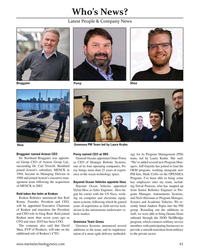 )
January 2023 - Marine Technology Reporter page: 45
)
January 2023 - Marine Technology Reporter page: 45in the autonomous underwater ve- group. Rounding out the additions to and CEO role to Greg Reid. Reid joined hicle market. staff, we were able to bring Dennis Doan Kraken more than seven years ago as onboard through the DOD SkillBridge CFO and since 2019 has been COO. program, which connects military
-
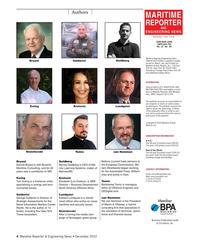 )
December 2022 - Maritime Reporter and Engineering News page: 4
)
December 2022 - Maritime Reporter and Engineering News page: 4printed issues) $140.00; two years $180.00 (18 printed issues) including postage and handling. Bryant Goldberg Bellona (current fuels advisors to Dennis Bryant is with Bryant’s Murray Goldberg is CEO of Ma- the European Commission), Wil- Maritime Consulting, and for 20 rine Learning Systems, maker of
-
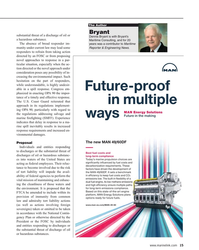 )
November 2022 - Maritime Reporter and Engineering News page: 15
)
November 2022 - Maritime Reporter and Engineering News page: 15The Author Bryant substantial threat of a discharge of oil or Dennis Bryant is with Bryant’s a hazardous substance. Maritime Consulting, and for 20 The absence of broad responder im- years was a contributor to Maritime munity under current law may lead some Reporter & Engineering News. responders to
-
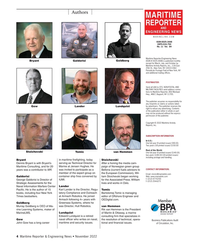 )
November 2022 - Maritime Reporter and Engineering News page: 4
)
November 2022 - Maritime Reporter and Engineering News page: 4printed issues) $140.00; two years $180.00 (18 printed issues) including postage and handling. Bryant in maritime ? re? ghting, today Stoichevski Dennis Bryant is with Bryant’s serving as Technical Director for After a honing the media cam- Maritime Consulting, and for 20 Marine at Jensen Hughes. He
-
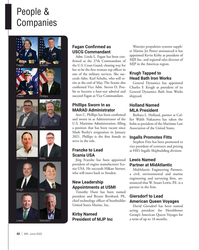 )
June 2022 - Marine News page: 42
)
June 2022 - Marine News page: 42People & Companies Waterjet propulsion systems suppli- Fagan Con? rmed as er Marine Jet Power announced it has USCG Commandant appointed Kevin Kirby as president of Adm. Linda L. Fagan has been con- ? rmed as the 27th Commandant of MJP, Inc. and regional sales director of Fagan Schultz the U.S.
-
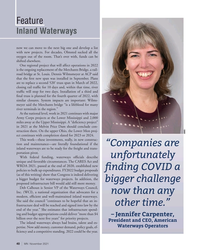 )
November 2021 - Marine News page: 40
)
November 2021 - Marine News page: 40elsewhere. One regional project that will affect operations in 2022 is the ongoing replacement of the Merchants Bridge, a rail- road bridge at St. Louis. Dennis Wilmsmeyer at ACP said that the ? rst new span was installed in September. Plans are to replace a second 520’ truss span in March of 2022, closing
-
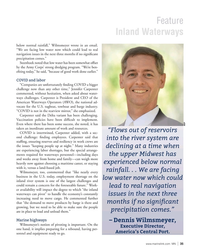 )
November 2021 - Marine News page: 35
)
November 2021 - Marine News page: 35is there and growing, but we need to be able to make sure the people precipitation comes.” are in place to load and unload them.” Marine highways – Dennis Wilmsmeyer, Wilmsmeyer’s notion of pivoting is important. On the Executive Director, one hand, it implies preparing for a rebound, having per- America’s
-
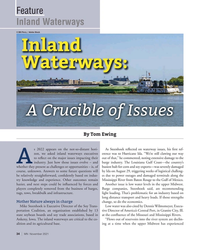 )
November 2021 - Marine News page: 34
)
November 2021 - Marine News page: 34strengths Mother Nature always in charge change, so do the economics. Mike Steenhoek is Executive Director of the Soy Trans- Low water was also cited by Dennis Wilmsmeyer, Execu- portation Coalition, an organization established by 13 tive Director of America’s Central Port, in Granite City, Ill. state soybean
-
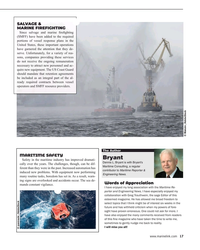 )
May 2021 - Maritime Reporter and Engineering News page: 17
)
May 2021 - Maritime Reporter and Engineering News page: 17operators and SMFF resource providers. © Maksim /AdobeStock The Author MARITIME SAFETY Bryant Safety in the maritime industry has improved dramati- Dennis L. Bryant is with Bryant’s cally over the years. The challenges, though, can be dif- Maritime Consulting, a regular ferent than they were in the
-
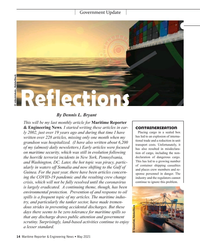 )
May 2021 - Maritime Reporter and Engineering News page: 14
)
May 2021 - Maritime Reporter and Engineering News page: 14Government Update © videotrinkets /AdobeStock Reflections By Dennis L. Bryant This will be my last monthly article for Maritime Reporter & Engineering News. I started writing these articles in ear- CONTAINERIZATION Placing cargo in a sealed box ly 2002, just over 19 years ago and during that time I have
-
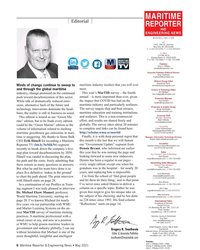 )
May 2021 - Maritime Reporter and Engineering News page: 6
)
May 2021 - Maritime Reporter and Engineering News page: 6Circulation our “Government Update” segment from Reporter TV (bit.ly/3nMikNt) segment Kathleen Hickey [email protected] 212-477-6700 ext 6320 Dennis Bryant, who informed me earlier recently to break down the company’s ? ve- Sales this year that he was turning the page and step plan toward decarbonizati
-
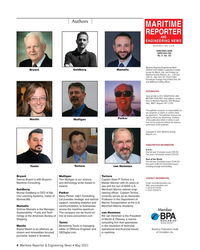 )
May 2021 - Maritime Reporter and Engineering News page: 4
)
May 2021 - Maritime Reporter and Engineering News page: 4$140.00; two years $180.00 (18 printed issues) Tomic Tortora van Hemmen including postage and handling. Bryant Mulligan Tortora CONTACT INFORMATION: Dennis Bryant is with Bryant’s Tom Mulligan is our science Captain Sean P. Tortora is a Maritime Consulting. and technology writer based in Master Mariner
-
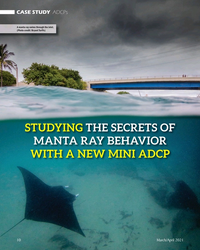 )
March 2021 - Marine Technology Reporter page: 10
)
March 2021 - Marine Technology Reporter page: 10CASE STUDY ADCPs A manta ray swims through the inlet. (Photo credit: Bryant Turffs) STUDYING THE SECRETS OF MANTA RAY BEHAVIOR WITH A NEW MINI ADCP 10 March/April 2021 MTR #3 (1-17).indd 10 3/22/2021 5:55:02 PM
-
 )
April 2021 - Maritime Reporter and Engineering News page: 17
)
April 2021 - Maritime Reporter and Engineering News page: 17the best way long-term way to address such criminal activity is to rebuild the economies and civil societies in the coastal areas. The Author Bryant Dennis L. Bryant is with Bryant’s Maritime Consulting, a regular contributor to Maritime Reporter & Engineering News. MR #4 (1-17).indd 17 4/1/2021
-
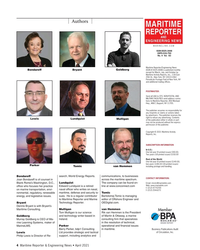 )
April 2021 - Maritime Reporter and Engineering News page: 4
)
April 2021 - Maritime Reporter and Engineering News page: 4contributor Bartolomej Tomic is managing to Maritime Reporter and Marine editor of Offshore Engineer and Bryant Technology Reporter. OEDigital.com. Dennis Bryant is with Bryant’s Maritime Consulting. Mulligan van Hemmen Member Tom Mulligan is our science Rik van Hemmen is the President Goldberg and technology
-
 )
February 2021 - Maritime Reporter and Engineering News page: 17
)
February 2021 - Maritime Reporter and Engineering News page: 17those provisions or even a thorough analysis of the few highlighted here. Those interested should review the legislation in depth. The Author Bryant Dennis L. Bryant is with Bryant’s Maritime Consulting, a regular contributor to Maritime Reporter & Engineering News. MR #2 (1-17).indd 17 2/4/2021
-
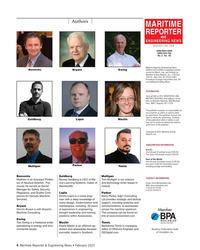 )
February 2021 - Maritime Reporter and Engineering News page: 4
)
February 2021 - Maritime Reporter and Engineering News page: 4tactical crane design, modernization and support, including analytics and Bryant maintenance, including 20 years communications, to businesses Dennis Bryant is with Bryant’s of experience in engineering, across the maritime spectrum. Member Maritime Consulting. thought leadership and training The
-
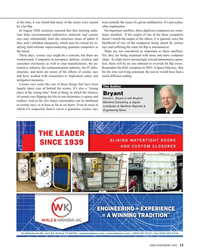 )
January 2021 - Maritime Reporter and Engineering News page: 13
)
January 2021 - Maritime Reporter and Engineering News page: 13also a “wrong place at the wrong time” kind of thing, in which the chances Bryant of cosmic rays ? ipping the bits in our electronics is sparse and Dennis L. Bryant is with Bryant’s random. And so far, few major catastrophes can be attributed Maritime Consulting, a regular to cosmic rays, or at least
-
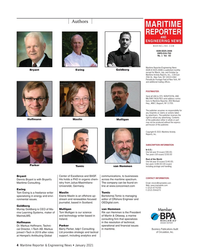 )
January 2021 - Maritime Reporter and Engineering News page: 4
)
January 2021 - Maritime Reporter and Engineering News page: 4Parker Tomic van Hemmen including postage and handling. Bryant Center of Excellence and BASF. communications, to businesses CONTACT INFORMATION: Dennis Bryant is with Bryant’s His holds a PhD in organic chem- across the maritime spectrum. Maritime Consulting. istry from Julius-Maximilians- The company
-
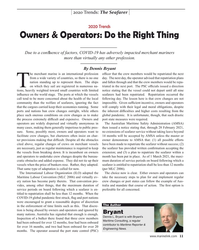 )
December 2020 - Maritime Reporter and Engineering News page: 11
)
December 2020 - Maritime Reporter and Engineering News page: 11Do the Right Thing Due to a con? uence of factors, COVID-19 has adversely impacted merchant mariners more than virtually any other profession. By Dennis Bryant he merchant marine is an international profession of? cer that the crew members would be repatriated the next from a wide variety of countries
-
 )
December 2020 - Maritime Reporter and Engineering News page: 4
)
December 2020 - Maritime Reporter and Engineering News page: 4(12 issues) $189.00; two years $228.00 (24 issues) including postage and handling. Tomic Mulligan van Hemmen Bryant Gray Tomic CONTACT INFORMATION: Dennis Bryant is with Bryant’s Andrew Gray, Director & Mariner, Bartolomej Tomic is managing Maritime Consulting. Campbell Johnston Clark’s Lon- editor of
-
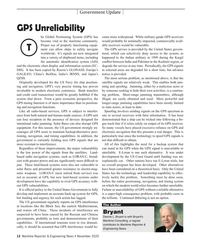 )
November 2020 - Maritime Reporter and Engineering News page: 12
)
November 2020 - Maritime Reporter and Engineering News page: 12, the eastern Mediterranean, and waters off China. These incidents of interference are Bryant suspected to have been caused by the Russian and Chinese Dennis L. Bryant is with Bryant’s governments, probably as tests and demonstrations of their Maritime Consulting, a regular capabilities. If international
-
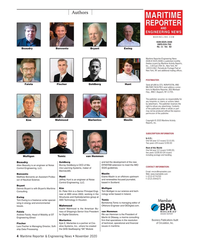 )
November 2020 - Maritime Reporter and Engineering News page: 4
)
November 2020 - Maritime Reporter and Engineering News page: 4of Nautical Science. Jeffrey Hunt is an engineer at Noise and renewables focused journalist, Control Engineering, LLC. based in Scotland. Bryant Dennis Bryant is with Bryant’s Maritime Kim Mulligan Consulting. Dr. Peter Kim is a Senior Principal Engi- Tom Mulligan is our science and tech- neer at ABS
-
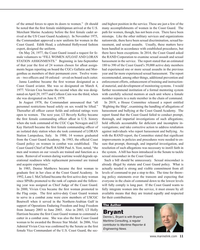 )
October 2020 - Maritime Reporter and Engineering News page: 11
)
October 2020 - Maritime Reporter and Engineering News page: 11Freedom and Iraqi Freedom from January 2003 to June 2003. Also in 2003, LT Holly Bryant Harrison became the ? rst Coast Guard woman to command a Dennis L. Bryant is with Bryant’s cutter in a combat zone. She was also the ? rst Coast Guard Maritime Consulting, a regular woman to be awarded the
